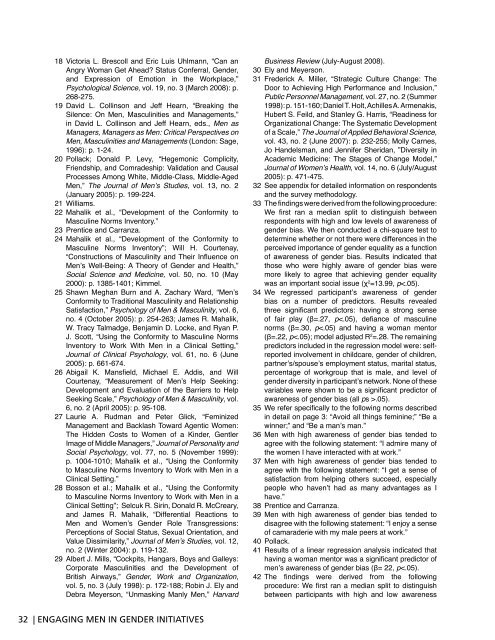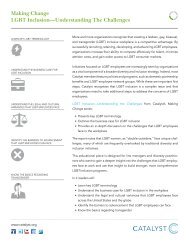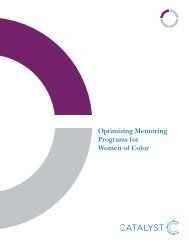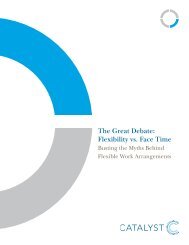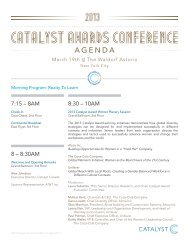ENgAgiNg MEN iN gENdEr iNiTiATivEs - Catalyst
ENgAgiNg MEN iN gENdEr iNiTiATivEs - Catalyst
ENgAgiNg MEN iN gENdEr iNiTiATivEs - Catalyst
- No tags were found...
Create successful ePaper yourself
Turn your PDF publications into a flip-book with our unique Google optimized e-Paper software.
18 Victoria L. Brescoll and Eric Luis Uhlmann, “Can anAngry Woman Get Ahead? Status Conferral, Gender,and Expression of Emotion in the Workplace,”Psychological Science, vol. 19, no. 3 (March 2008): p.268-275.19 David L. Collinson and Jeff Hearn, “Breaking theSilence: On Men, Masculinities and Managements,”in David L. Collinson and Jeff Hearn, eds., Men asManagers, Managers as Men: Critical Perspectives onMen, Masculinities and Managements (London: Sage,1996): p. 1-24.20 Pollack; Donald P. Levy, “Hegemonic Complicity,Friendship, and Comradeship: Validation and CausalProcesses Among White, Middle-Class, Middle-AgedMen,” The Journal of Men’s Studies, vol. 13, no. 2(January 2005): p. 199-224.21 Williams.22 Mahalik et al., “Development of the Conformity toMasculine Norms Inventory.”23 Prentice and Carranza.24 Mahalik et al., “Development of the Conformity toMasculine Norms Inventory”; Will H. Courtenay,“Constructions of Masculinity and Their Influence onMen’s Well-Being: A Theory of Gender and Health,”Social Science and Medicine, vol. 50, no. 10 (May2000): p. 1385-1401; Kimmel.25 Shawn Meghan Burn and A. Zachary Ward, “Men’sConformity to Traditional Masculinity and RelationshipSatisfaction,” Psychology of Men & Masculinity, vol. 6,no. 4 (October 2005): p. 254-263; James R. Mahalik,W. Tracy Talmadge, Benjamin D. Locke, and Ryan P.J. Scott, “Using the Conformity to Masculine NormsInventory to Work With Men in a Clinical Setting,”Journal of Clinical Psychology, vol. 61, no. 6 (June2005): p. 661-674.26 Abigail K. Mansfield, Michael E. Addis, and WillCourtenay, “Measurement of Men’s Help Seeking:Development and Evaluation of the Barriers to HelpSeeking Scale,” Psychology of Men & Masculinity, vol.6, no. 2 (April 2005): p. 95-108.27 Laurie A. Rudman and Peter Glick, “FeminizedManagement and Backlash Toward Agentic Women:The Hidden Costs to Women of a Kinder, GentlerImage of Middle Managers,” Journal of Personality andSocial Psychology, vol. 77, no. 5 (November 1999):p. 1004-1010; Mahalik et al., “Using the Conformityto Masculine Norms Inventory to Work with Men in aClinical Setting.”28 Bosson et al.; Mahalik et al., “Using the Conformityto Masculine Norms Inventory to Work with Men in aClinical Setting”; Selcuk R. Sirin, Donald R. McCreary,and James R. Mahalik, “Differential Reactions toMen and Women’s Gender Role Transgressions:Perceptions of Social Status, Sexual Orientation, andValue Dissimilarity,” Journal of Men’s Studies, vol. 12,no. 2 (Winter 2004): p. 119-132.29 Albert J. Mills, “Cockpits, Hangars, Boys and Galleys:Corporate Masculinities and the Development ofBritish Airways,” Gender, Work and Organization,vol. 5, no. 3 (July 1998): p. 172-188; Robin J. Ely andDebra Meyerson, “Unmasking Manly Men,” HarvardBusiness Review (July-August 2008).30 Ely and Meyerson.31 Frederick A. Miller, “Strategic Culture Change: TheDoor to Achieving High Performance and Inclusion,”Public Personnel Management, vol. 27, no. 2 (Summer1998): p. 151-160; Daniel T. Holt, Achilles A. Armenakis,Hubert S. Feild, and Stanley G. Harris, “Readiness forOrganizational Change: The Systematic Developmentof a Scale,” The Journal of Applied Behavioral Science,vol. 43, no. 2 (June 2007): p. 232-255; Molly Carnes,Jo Handelsman, and Jennifer Sheridan, ”Diversity inAcademic Medicine: The Stages of Change Model,”Journal of Women’s Health, vol. 14, no. 6 (July/August2005): p. 471-475.32 See appendix for detailed information on respondentsand the survey methodology.33 The findings were derived from the following procedure:We first ran a median split to distinguish betweenrespondents with high and low levels of awareness ofgender bias. We then conducted a chi-square test todetermine whether or not there were differences in theperceived importance of gender equality as a functionof awareness of gender bias. Results indicated thatthose who were highly aware of gender bias weremore likely to agree that achieving gender equalitywas an important social issue (χ 2 =13.99, p


